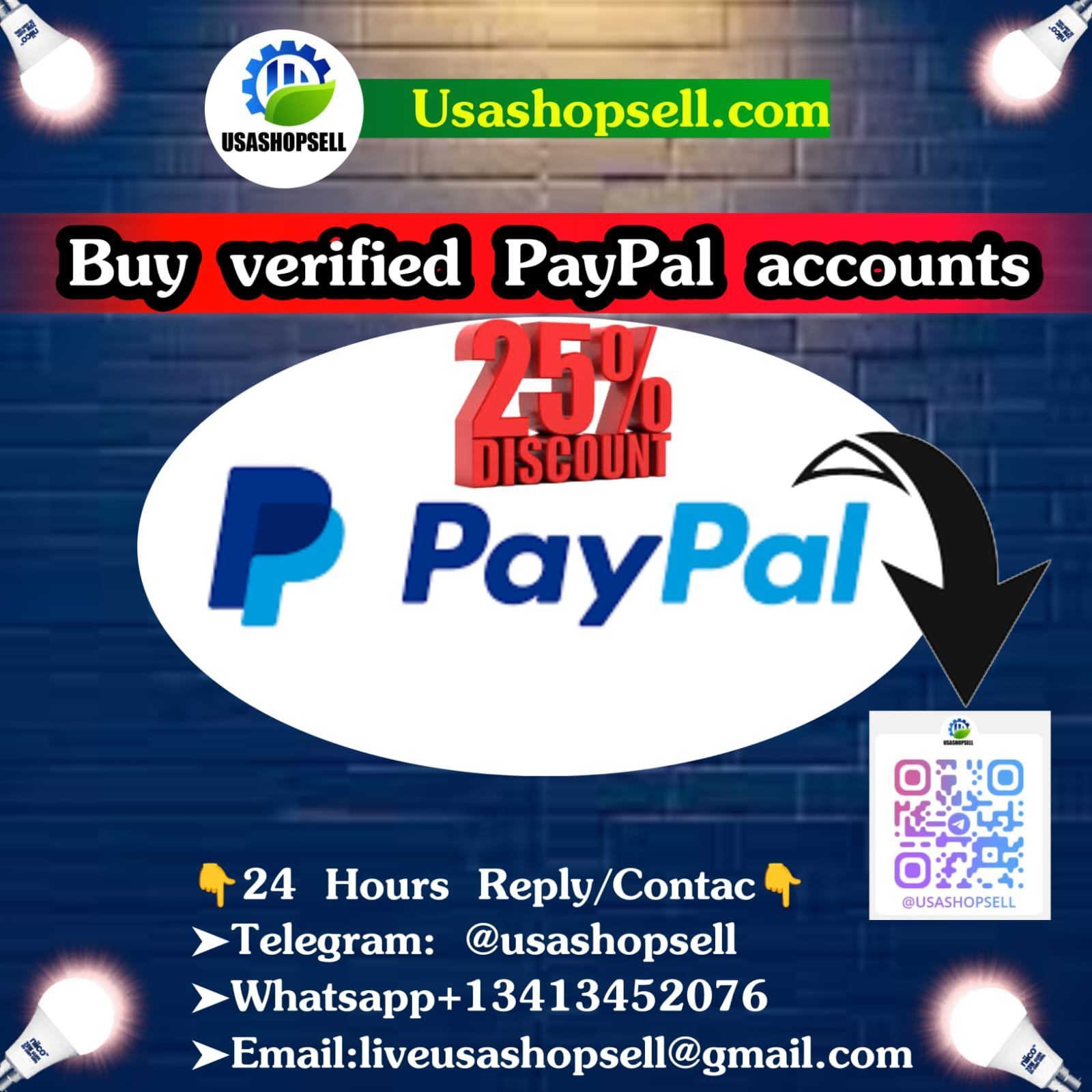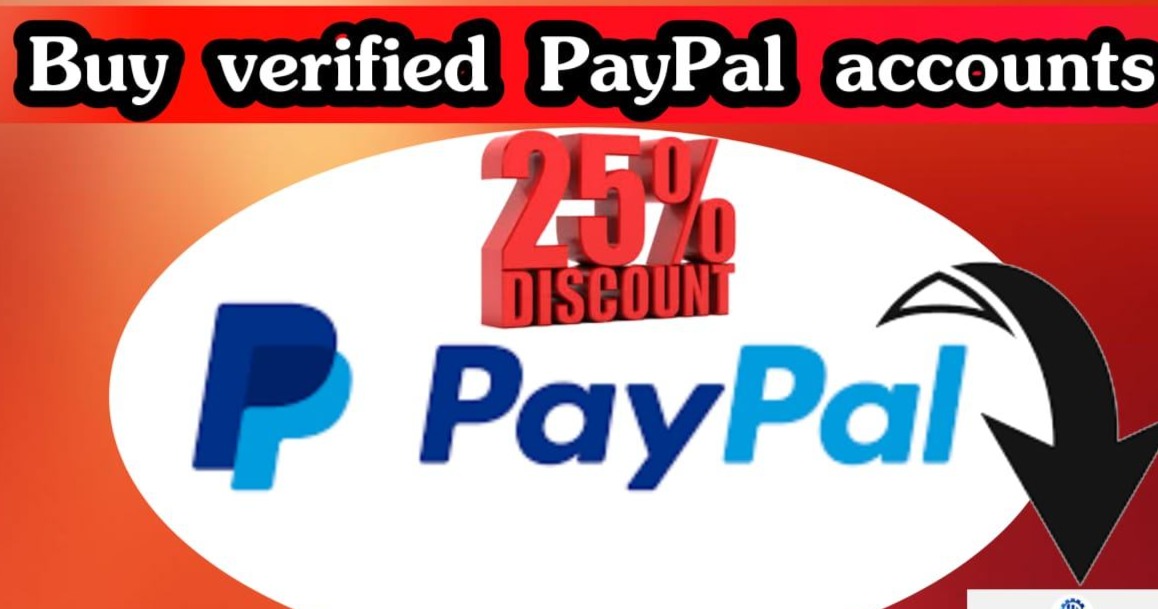Buy Verified PayPal Accounts: The Risks and Dangers You Need to Know
In the world of online transactions, PayPal has established itself as one of the most widely used platforms for sending and receiving money. Whether you're shopping online, accepting payments for goods or services, or transferring funds internationally, a verified PayPal account

can offer additional features like higher transaction limits and greater security. But, in some cases, people might seek out a shortcut to getting a verified account by purchasing one from third-party sellers.
While buying a verified PayPal account might seem like a convenient way to bypass the verification process, it comes with significant risks. In this article, we’ll walk you through the potential dangers, why you should avoid buying verified PayPal accounts, and how you can protect yourself if you choose to go down that path.
contact now-
24 Hours Reply/Contac
➤Telegram: @usashopsell
➤Whatsapp+13413452076
➤Email:liveusashopsell@gmail.com
Why Buying Verified PayPal Accounts Is Risky
Before considering buying a verified PayPal account, it's crucial to understand the risks involved. Here's why this practice is not only dangerous but also potentially illegal:
1. Violation of PayPal's Terms of Service
Buying or selling verified PayPal accounts directly violates PayPal’s User Agreement and Acceptable Use Policy. PayPal prohibits any transfer, sale, or purchase of accounts or account information. If PayPal detects that you've purchased an account, they can suspend or permanently ban it, even if the account is verified and functioning at the time of purchase.
Consequences of violating PayPal’s terms can include:
- Permanent loss of funds: PayPal will likely freeze any balances in the account, meaning you could lose access to the money you’ve transferred or stored.
- Account suspension: Your PayPal account may be permanently banned, preventing you from making future transactions.
- Legal issues: In some jurisdictions, buying or selling PayPal accounts can lead to legal repercussions.
2. Account Hijacking and Fraud Risks
When you purchase a verified PayPal account from an unknown third party, you expose yourself to fraud and scams. The seller may retain access to the account, allowing them to reclaim control after you’ve made your purchase. This situation is commonly known as "account hijacking."
Additionally, some accounts are created or stolen with malicious intent and may have been compromised. If you purchase an account from an untrustworthy source, you may unknowingly be putting your financial information and personal data at risk.
3. Data Breaches and Personal Information Theft
If you’re purchasing a PayPal account that has been tampered with, there’s a high chance that the account contains your sensitive personal or financial data. The seller might retain access to this information and could use it for malicious purposes.
If the account was previously compromised, your personal information, including credit card numbers, addresses, and email addresses, might be exposed to third parties. Even if you change the password, there’s still a chance that malicious actors could take advantage of any lingering vulnerabilities.
4. Financial Losses and Chargebacks
Even if you manage to acquire a legitimate account, you may find yourself vulnerable to financial loss. Fraudulent sellers may provide you with a fake or "stolen" account, or one that is flagged by PayPal. In such cases, you might lose the money you've paid for the account. Additionally, if you use the account for business purposes, PayPal could reverse transactions or initiate chargebacks, potentially costing you even more.
How to Protect Yourself When Buying Verified PayPal Accounts
While it’s highly recommended that you avoid purchasing verified PayPal accounts altogether, if you still choose to proceed, here are a few strategies to minimize your risks:
1. Do Thorough Research on the Seller
Before purchasing a verified PayPal account, it’s crucial to conduct extensive research on the seller. Some scammers will go to great lengths to appear legitimate, so look out for the following red flags:
- Seller Reputation: Check online reviews or testimonials from past buyers. Look for feedback on trusted forums, websites, and social media platforms. If you can’t find any feedback or the reviews seem fabricated, avoid the transaction.
- Seller Transparency: A trustworthy seller should be open and willing to answer your questions about the account, its history, and the verification process. They should also provide you with verifiable proof that the account is verified and active.
- Third-Party Verification: Use independent platforms or escrow services to validate the transaction. These platforms can act as intermediaries to ensure that both parties are protected during the exchange.
2. Request Proof of Account Ownership and Verification
To confirm the legitimacy of the account, request detailed proof from the seller. This might include:
- Proof of Verified Status: Ask for a screenshot showing the PayPal account’s verified status. PayPal verification is typically indicated by a checkmark on the account.
- Account Activity: Ensure the account has recent transaction history. An account that is "too clean" or lacks activity might be a red flag that it’s newly created and may not yet be secure.
- Email or Phone Confirmation: Confirm that the email or phone number associated with the PayPal account matches the seller's details. This will reduce the chances of the seller retaining access to the account after the transaction.
3. Avoid Untraceable Payment Methods
Scammers often request payment through untraceable methods such as cryptocurrency, gift cards, or wire transfers. Avoid these types of payments as they offer no protection once the transaction is completed.
Instead, opt for secure, traceable payment methods such as:
- PayPal (with buyer protection): If you must make the purchase, use PayPal itself (although PayPal typically forbids buying or selling accounts). Using PayPal's buyer protection ensures that you have a degree of recourse if the seller doesn’t fulfill the terms of the transaction.
- Credit Cards: Credit cards generally offer fraud protection, and many credit card companies will assist you in disputing fraudulent transactions.
4. Ensure Security After the Purchase
Once you have access to the account, it’s critical to secure it. Take the following steps immediately:
- Change the Account Password: After logging into the account, change the password to something strong and unique. Make sure it’s not easily guessable and contains a mix of uppercase and lowercase letters, numbers, and special characters.
- Enable Two-Factor Authentication (2FA): Enable two-factor authentication to add an extra layer of security to the account. This requires a second form of authentication (usually via phone or email) to access the account, even if someone knows the password.
- Update Account Details: If the account is linked to the seller's email, phone number, or other personal information, change those details to your own. This will help ensure that you maintain full control over the account.
5. Monitor the Account Regularly
Even after securing the account, continue monitoring it for any suspicious activity:
- Transaction Alerts: Set up transaction alerts to notify you of any payments made from the account. This will allow you to spot unauthorized transactions as soon as they occur.
- Review Account Activity: Periodically review the account’s transaction history to ensure that everything is legitimate. If you notice any unusual activity, contact PayPal immediately and report it.
contact now-
24 Hours Reply/Contac
➤Telegram: @usashopsell
➤Whatsapp+13413452076
➤Email:liveusashopsell@gmail.com
Alternatives to Buying Verified PayPal Accounts
Rather than risking your security and finances by purchasing a verified PayPal account, consider these safer alternatives:
- Complete the Verification Process Yourself: Creating and verifying your own PayPal account is quick and easy. PayPal typically requires you to link a bank account or credit card and verify your phone number or email to achieve a verified status. This ensures that your account is secure and compliant with PayPal’s terms.
- Upgrade to PayPal Business: If you're looking for additional features, such as higher transaction limits, consider upgrading to PayPal Business or PayPal Premier. These accounts are legitimate, offer greater flexibility, and allow you to conduct professional transactions without the risks associated with buying accounts.
- Use PayPal Alternatives: If you’re worried about PayPal’s limitations, consider using other secure payment platforms, such as Stripe, Square, or Venmo, depending on your needs.
